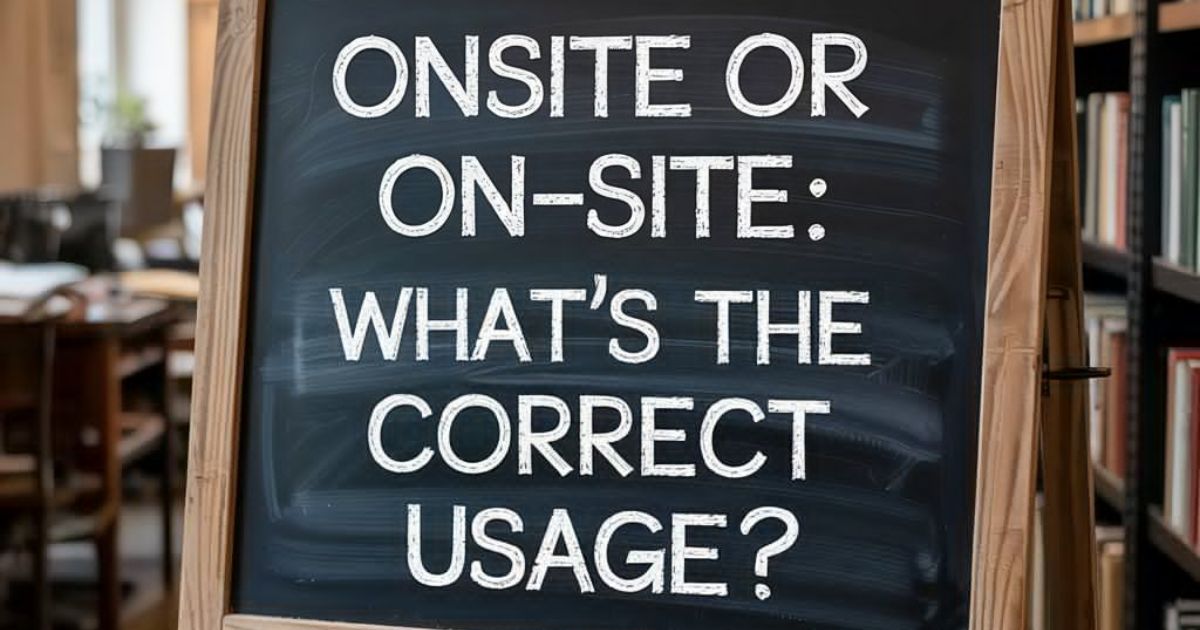When it comes to writing Onsite or On-Site, many people wonder which version is correct. Both onsite and on-site are widely used, but there are some differences in their meanings and contexts. If you’re unsure about onsite versus on site or on site vs onsite, it’s important to understand when to use each. Onsite (one word) is commonly used in informal writing, especially in business, tech, and marketing. However, on-site (hyphenated) is more formal and appears in legal, technical, and academic contexts.
The question often arises, is onsite one word? Yes, in most cases, Onsite or On-Site is written as a single word in modern, informal contexts. But if you’re working with more formal content, you may find on-site vs onsite or onsite vs on-site being used depending on the style guide. Both forms are correct, but consistency is key in your writing.
Understanding Onsite or On-Site

When it comes to writing onsite or on-site, many people get confused. Is onsite one word, or should it always be written as on-site with a hyphen? The truth is, both versions are used in modern English, but their acceptability depends on the writing style and context. If you’re debating between onsite versus on site, it’s important to know when each is appropriate. Style guides like AP or Chicago typically favor on-site, especially in formal writing. However, digital and business communication often lean toward onsite for a clean and modern look.
This difference is what fuels the ongoing debate: onsite vs on-site, on-site vs onsite, and on site vs onsite. They all point to the same idea, something occurring at a particular physical location, but how you write it can change the tone of your message. So, let’s break it down further.
On-Site: Definition and Usage
The term on-site is a hyphenated adjective typically used before a noun. It’s preferred in formal and traditional writing. For example:
- “We provide on-site technical support for all our clients.”
- “An on-site evaluation is scheduled for next week.”
In both examples, on-site modifies the noun that follows. So, in the context of on-site vs onsite, the hyphenated version brings clarity and follows standard grammar rules. Still confused about onsite or on-site? Think of it this way, use the hyphen when you’re writing formally or for publication.
Onsite: Definition and Usage
Onsite, without the hyphen, is gaining popularity, especially in business and tech circles. It’s considered more modern and is often found in emails, websites, and company blogs. For example:
- “Our technician will be onsite tomorrow.”
- “We’re hosting an onsite workshop this Friday.”
In the debate of onsite vs on-site, onsite feels more casual but still widely accepted. Whether you’re writing onsite or on-site, consistency is key. Once you choose a version, stick with it throughout your content. And when deciding on site vs onsite, ask yourself who your audience is and which style fits your brand voice best.
Onsite Child Care
- If your company supports working parents, they might provide helpful benefits like onsite child care right at the office.
- Many businesses choose on-site child care to make it easier for employees to balance work and family life.
- The big question people ask is, is onsite one word or should it be hyphenated as on-site?
- Whether it’s called onsite or on-site, the purpose is the same, making childcare more accessible for staff.
- In HR manuals, you’ll often see both versions used, which sparks the debate: onsite vs on-site and on site vs onsite.
Onsite Training
- If your team needs skill-building without the hassle of travel, they’ll probably get access to onsite training sessions.
- Companies often choose on-site training to keep employees learning without disrupting daily work.
- Wondering is onsite one word? You’ll see both onsite and on-site used, depending on the company’s writing style.
- From safety procedures to software updates, onsite or on-site training brings education straight to the job site.
- Comparing onsite vs on-site? The difference is mostly about preference, not meaning.
“On site”: Meaning and Common Uses
“On site” refers to something located directly at a specific place or location, such as a workplace, construction area, or event venue. It’s commonly used in business and professional contexts to distinguish between activities happening at the job site versus remotely. While on-site or onsite are also common, on site (two words) remains the traditional and formal version.
Common Uses
- The phrase “on site” is used to describe something located at a specific physical location, such as a workplace, factory, or event venue.
- It’s popular in industries like construction, tech, healthcare, and manufacturing to distinguish between remote or offsite work.
- You’ll often hear debates like on site vs onsite or onsite vs on-site, but in more formal documents, the two-word version, on site, is preferred.
- Companies might choose on site to align with traditional grammar, even though onsite or on-site are becoming more common in modern writing.
Examples
- “All new employees must attend on site orientation during their first week.”
- “The repair technician will arrive on site within the hour.”
- “Our team provides on site support for all hardware-related issues.”
- “Construction begins on site this Monday.”
- “There are always medical professionals on site during large public events.”
Key Differences
- Spelling and Grammar:
- On site (two words) is the traditional form and is often used in more formal writing, like legal documents or older style guides.
- Onsite (one word) is the modern, more informal spelling, commonly used in digital content, marketing, and tech industries.
- On site (two words) is the traditional form and is often used in more formal writing, like legal documents or older style guides.
- Usage:
- On site is typically used in professional and technical contexts, especially when referring to something physically located at a specific job site or place.
- Onsite is becoming the preferred choice in many industries, especially in branding, advertising, and user-friendly content.
- On site is typically used in professional and technical contexts, especially when referring to something physically located at a specific job site or place.
- Consistency:
- It’s important to stay consistent with the spelling choice you make. If you use on site in one document, try to stick with that, and the same applies for onsite.
- It’s important to stay consistent with the spelling choice you make. If you use on site in one document, try to stick with that, and the same applies for onsite.
- Formality:
- On site can appear more formal and traditional, while onsite feels more modern and streamlined.
- On site can appear more formal and traditional, while onsite feels more modern and streamlined.
- Common Confusion:
- People often debate whether is onsite one word or two, and the truth is both forms are used interchangeably, but onsite is increasingly favored in everyday business use.
Everyday Usage of ‘Onsite’ or ‘On-Site’
- “Our IT team provides onsite support for any technical issues that arise during business hours.”
- “We prefer to hold onsite meetings with clients to discuss project updates and timelines.”
- “New hires will undergo onsite training in the company’s headquarters before they start working remotely.”
- “The company offers onsite services like repairs and maintenance directly at your location.”
- “The company offers onsite childcare, allowing parents to focus on their work without worrying about their kids.”
- “We conduct on-site inspections of the facilities to ensure compliance with safety regulations.”
- “Our on-site fitness center is available to employees who want to stay healthy during the workday.”
- “The company is hosting on-site career fairs for local job seekers next month.”
- “The training session will be on-site to ensure all employees receive hands-on instruction.”
- “Our on-site management team will assist with any issues that arise during the event.”
Related Guide:
Moment Vs Momment: Spelling + Definition + Usage
Onsite or On-Site: Both Words Are Correct!
“Onsite or On-Site”, both words are correct, but the choice often depends on the context in which they are used. Onsite (one word) has become more popular in modern, informal business writing, especially in industries like technology, marketing, and customer service.
It’s cleaner and more efficient, fitting the trend toward simplified language. However, in onsite versus on-site discussions, many still prefer on-site (hyphenated) for formal documents, legal writing, and technical reports due to its traditional use.
When comparing on site vs onsite or onsite vs on-site, it’s important to know that both are grammatically acceptable, but consistency is crucial. If you’re unsure about is onsite one word, it’s helpful to remember that both on-site vs onsite forms are correct, though onsite is increasingly used in digital and informal communications. Whether you opt for on-site vs onsite or onsite versus on site, the key is maintaining uniformity throughout your writing.
Side-by-Side Comparison
| Aspect | Onsite | On-site |
| Definition | Refers to something located at a specific place, typically used in modern, informal contexts. | Refers to something physically located at a specific place, typically used in more formal contexts. |
| Usage | Common in business, tech, marketing, and digital content. | Common in legal, technical, and formal documents. |
| Grammar | A more modern, simplified form (one word). | A traditional form, often preferred in formal writing (hyphenated). |
| Formality | Informal, increasingly used in everyday communication. | More formal, often found in professional, technical, or legal settings. |
| Popularity | Gaining popularity, especially in digital and customer-focused industries. | Still preferred in formal contexts, but less common in modern digital writing. |
| Examples | “We offer onsite support for all our products.” | “The on-site inspection will be conducted tomorrow.” |
| Consistency | Can be used in informal, marketing, and customer-oriented content. | Best used in formal writing, official reports, and contracts. |
Both Onsite and On-site are correct, but their usage depends on the context. Onsite is preferred in modern, informal business writing and digital content, while On-site remains the traditional choice in formal documents, legal writing, and technical reports.
It’s important to maintain consistency in your usage, whether you choose the simplified onsite or the more formal on-site. Ultimately, both terms are widely understood and grammatically acceptable.
Tips to Avoid Mistakes with “Onsite” and “On-Site”
- Know Your Audience
Onsite is often used in modern, informal writing, especially in digital content, marketing, and tech industries. If you’re writing for a more casual or customer-facing audience, onsite tends to be the better choice. However, On-site is better suited for formal contexts such as legal documents, technical reports, or academic writing. - Stay Consistent
Once you choose either onsite or on-site, it’s essential to stick to your choice throughout the entire document or presentation. Consistency helps avoid confusion for readers, while switching between the two forms can lead to inconsistencies. - Follow Industry Standards
Many industries or companies have specific preferences for spelling. If you’re unsure which to use, check your industry’s style guide or research common usage. For example, tech companies may prefer onsite, while sectors like construction or engineering might opt for on-site. - Be Mindful of Your Writing Style
If you’re writing in a more informal tone, such as for blogs or marketing content, onsite is often preferred due to its simplicity and directness. For formal, professional, or technical writing, on-site may feel more traditional and polished.
Onsite or On-Site in Oxford Dictionary
According to the Oxford Dictionary, on-site (hyphenated) is listed as the correct spelling. The hyphen helps clarify the connection between “on” and “site,” emphasizing the physical presence at a specific location. In contrast, onsite (one word) is becoming increasingly common in modern business, digital, and marketing contexts, though it is not yet officially listed as a standard spelling in the Oxford Dictionary.
Example (Oxford Dictionary style):
- “The company offers on-site training for all new employees.”
- “The on-site manager will handle all operational issues during the event.”
Onsite or On-Site in Chicago Style

In Chicago Style writing, the preference is for on-site (hyphenated). Chicago Style tends to favor more traditional spelling, particularly in formal and academic writing. Although onsite is becoming more popular in casual contexts, Chicago Style maintains the hyphenated version to preserve clarity and readability, especially in formal texts like books, scholarly articles, and reports.
Example (Chicago Style):
- “The construction team will begin the on-site survey next week.”
- “An on-site inspection is required before approval of the permit.”
FAQ’s
How do I choose between onsite or on-site?
It depends on the context. Onsite or On-Site is often used in formal writing, while the one-word version is commonly used in casual business content.
Is there a difference in formality between onsite and on-site?
Yes, onsite or on-site in its hyphenated form tends to be more formal, while the one-word version is generally used in less formal, modern writing.
When should I use onsite?
You should use onsite or on-site when referring to services or locations in a less formal, modern business setting. It’s more common in digital content.
Can I use onsite for legal documents?
For legal documents, it’s best to use onsite or on-site in its hyphenated form, as it maintains clarity and aligns with traditional formal writing styles.
Which form is correct for academic writing?
In academic writing, onsite or on-site should be hyphenated to follow formal writing conventions. It adds precision and fits the tone of scholarly articles.
Conclusion
Whether you choose Onsite or On-Site, both terms are correct but serve different purposes. Onsite (one word) is more commonly used in informal writing, such as in business or marketing materials. If you’re wondering, is onsite one word, the answer is yes, it’s usually written as one word in modern contexts. On the other hand, on-site (hyphenated) is preferred in more formal settings, like legal, academic, or technical writing.
Understanding the difference between onsite versus on site or on site vs onsite is key to using them properly. If you’re comparing onsite vs on-site or on-site vs onsite, just remember to follow the style guide you’re working with. Consistency is important, so whichever form you choose, stick with it throughout your writing. Both Onsite or On-Site versions are widely accepted, but knowing when and where to use each will ensure clarity and professionalism.

Ember Rose is a dedicated administrator with 4 years of experience in efficient operations management and team leadership. Skilled in streamlining workflows and enhancing productivity.

